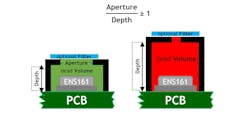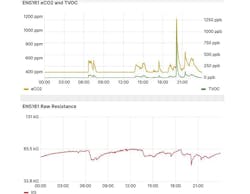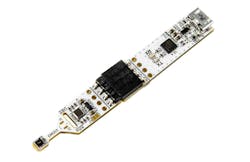What you’ll learn:
- Why air quality matters in building automation, and the features of MOX technology.
- How easily ScioSense's ENS161 sensor fits into a building automation system.
Building automation is revolutionizing the way we interact with our environments, offering seamless control, efficiency, and comfort at our fingertips. Within the sphere of building automation and intelligent housing, everyone is racing to embrace cutting-edge technologies and maximize energy efficiency. However, one crucial aspect often gets left behind: indoor air quality and the potential risks it poses.
Given that people spend most of their time indoors, improving indoor air quality is essential for public health. Recent studies on indoor air quality have highlighted the concerning reality that many individuals are consistently exposed to a cocktail of gases. While not immediately life-threatening, these gases can have negative consequences over time, potentially leading to various health issues.
When indoor air isn’t sufficiently ventilated, contaminants build up, negatively impacting our health, but also reducing our ability to recall information and maintain productivity. From building materials to everyday activities like cooking, our indoor spaces are inundated with volatile organic compounds (VOCs), an ever-present yet invisible threat, often ignored or underestimated by most individuals.
No need to worry, though, because there's a straightforward solution: metal oxide technology (MOX). Embracing efficient ventilation technologies isn't just about creating comfortable indoor environments. It’s about safeguarding our planet's health and our wallet.
Effortless Integration and Optimal Performance
In the context of the smart building, the MOX sensor emerges as an ideal solution. Composed of a metal oxide layer on a sensing chip and a heater underneath, the sensor’s MOX changes its electrical resistance depending on the ambient gas concentration, from which the air quality can be derived. Among the available MOX technologies, ScioSense’s ENS161 sensor requires minimal integration effort both at the hardware and software levels.
The ENS161 is a low-power-consumption but powerful device supporting improved and intelligent algorithms to turn raw data into total VOC (eTVOC), equivalent CO2 (eCO2), and additional air-quality indices, without any special experience or knowledge needed by the end-user. These real-time outputs allow for proactive adjustments to ventilation settings, ensuring a consistently healthy indoor environment based on your occupancy needs. Furthermore, its algorithm has recently been optimized specifically for home and building automation (HaBa) applications.
Integration of ENS161 in HaBa Applications
Beginning with electrical, followed by mechanical integration, recommendations are provided to ensure a clear and systematic process and address the invisible threats of your smart building.
Circuit design (Fig. 1):
- The sensor can communicate through I2C or SPI.
- The minimum supply voltage VDD is 1.71 V; it must not drop below this value to ensure reliable operation. A good power supply decoupling is recommended; therefore, decoupling capacitors need to be placed near pins 4 (VDD) and 5 (VDDIO), respectively 10 µF and 100 nF. VDDIO is the interface supply pins, i.e., 3.3 V.
- If using I2C communication, pin 7 (CSn) must be pulled high to select I2C mode, while pin 3 (MISO/ADDR) should be pulled low or high to specify the address LSB. “High” refers to VDDIO. In case of SPI, see the above circuit.
- In a test setup, when configuring the operational mode, please take care of proper contacts. Transient resistance from jumper wires could introduce a momentary drop in resistance and, therefore, a resulting current drop, potentially causing a reset in ENS161.
- Remember that the sensor operates at 1.8 V. Thus, if you have a typical 3.3-V or higher voltage source, it requires the introduction of a linear voltage regulator or a DC switching voltage regulator.
Mechanical Integration: Preserve Optimal Performance
Package and PCB
- The ENS161 features an open LGA package for standard reflow soldering (IPC/JEDEC J-STD-020D). Use no-clean solder paste and avoid board wash processes to protect the sensor area.
- The PCB materials proven are PI and FR4, while the housing materials are PA, ABS, ABS-GF, PC, PEEK, and PTFE. As a rule of thumb, any gas absorbing/desorbing materials should be avoided. Please also be aware that polymers may release VOCs at high temperatures.
Package on PCB
- During placement on the PCB, make sure there’s sufficient air exchange and venting at any time.
- During pick and place, limit Z-axis force to 10 N.
- The gap underneath the sensor should be kept between 30 and 50 µm to avoid stress on the sensor.
Conformal coating
- Conformal coating or lacquer must not touch the sensor at all. If it’s going to be used, please ensure to allow an exclusion area around it.
Housing and Extra Protection
- We should separate the sensor with its own housing to shrink the dead volume and make gas interaction more efficient. In case the housing’s volume is high, or ventilation can’t be guaranteed, the cavity’s aperture and depth should be at least equal—the larger the aperture, the better.
- For challenging conditions and extra protection, membranes or filters could be implemented on the cavity aperture to shield the housing from particles or water (Fig. 2).
- Furthermore, in case the sensor must be protected during the production process, we highly recommend using kapton tape or siloxane- and VOC-free materials only.
For questions or uncertainties, reach out to [email protected].
Mastering the Software
Now it's time to explore the software dimension. Little programming expertise is needed: the code and the libraries for Arduino IDE are public and available at https://github.com/sciosense. These are the steps for setting up the sensor and measurement, and, therefore, relying on efficient ventilation methods within your environment:
1. Include the libraries:
2. Choose the operating mode:
OR
OR
3. Setup the sensor:
4. Retrieve the measurements:
No additional sensor programming is needed:
- The integrated MCU eliminates concerns about the timing, wake-up operations, or compensation processes.
- Data processing is handled entirely on-chip, without requiring post-processing steps or the use of additional libraries.
- The new optimized algorithms allow for a low-power mode and an ultra-low-power mode for applications with minimal energy-consumption requirements (down to 150 µA).
Therefore, only the few steps mentioned are required to set up serial communications and read the sensor's data. To grasp the concept of ENS161, I would love to showcase the trends of TVOC, eCO2, and the resistance of the sensor element in a simple smart building scenario: my living room on a typical day out (Fig. 3).
It’s sensible to make two simple considerations:
- Notably, we see fluctuations before heading to work and in the evening, with the latter being more prominent—blame it on my dinner preparations. Further small variations are due to the radiators kicking in during the afternoon.
- When there’s a contamination source (whether it's our breath, sweat, or cooking), the resistance decreases and the quantity of VOCs in the air increases proportionally.
Known Pitfalls and More
In this article, we've covered the key aspects of the smart building and the related unseen risks, the MOX technology for its ability to detect airborne particles quickly and reliably, and, lastly, we introduced ScioSense’s ENS161 for its easy integration into any electronic systems. Still, there are potential “pitfalls” to be aware of:
- Are you thinking of turning the sensor on and off repeatedly to reduce power consumption? It would be a good idea if it weren't for the fact that the algorithm restarts at power-on or re-initialization of the sensor.
- Should the sensor be exposed to saturated alcohol fumes for an extended period, a recovery period is necessary.
- Rest assured, the sensor is wind-speed immune, verified through specific tests conducted in our laboratories.
Looking for Evaluation?
Reputable brands such as Adafruit, DFRobot, MIKROE, and Sparkfun are available at distributors like Digi-Key and Mouser to start the prototyping experience in your building.
The ScioSense Evaluation Kit can be connected to I2C or through the I2C-to-USB bridge with a ready-to-go dashboard. The dashboard provides access to all output values and enables visualization and logging of the sensor's data (Fig. 4).




